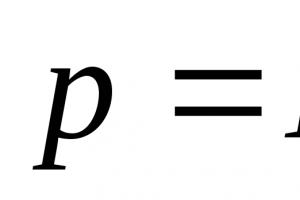Laminate is rightfully considered one of the most popular types of flooring. It is distinguished by its beautiful appearance, durability and ease of installation. However, all work on its installation must be carried out in accordance with certain requirements, otherwise even the most quality material will fall into disrepair too quickly. Many novice craftsmen have a natural question: how to lay laminate correctly, along or across the room? There is no definite answer to this, so let’s figure out what will determine the direction of orientation of the lamellas during installation.
How to lay laminate flooring correctly - lengthwise or crosswise
If you listen to advice experienced craftsmen, then you can hear that there is one rule, according to which the orientation of the slats in the rooms is carried out. The direction of the coating strips depends entirely on where the main light source is located(for example, a window or bright lamps that will replace the first option in a windowless room).

Why will the direction of the lamellas depend on the light source? It’s simple - the rays of the sun or the light emitted by a lamp, hitting the material perpendicularly (at an angle of 90 degrees), will demonstrate all the joints. They will be especially noticeable if the lamellas are joined poorly. And therefore, the laminate is always laid so that the coating strips are located along the rays of light - only then can the visibility of the joints be reduced. Thus, the slats will lie with their narrow side facing the window, and the installation of the covering is carried out starting from one of the side walls of the room (usually from the one where there are no doors).

On a note! Where there is no natural light source, laminate is placed using an artificial one.
Prices for Tarkett laminate
Tarquette laminate
Laminate laying direction
Laminate manufacturers note that this coating is very easy to install and anyone can cope with this task. Yes, this is partly true, since the slats are equipped with special locks that allow them to be easily fastened together. If initially laminate was on sale only with a Lock lock, which requires certain skills to work with it, now it has become widespread the new kind connections are Click locks, which really anyone can connect. We'll talk about them a little later.
On a note! Technologies do not stand still and are developing, and therefore completely new lamellas with 5G and Megalock connecting systems are entering the market.


In reality, everything turns out to be much more complicated than laminate manufacturers kindly reported. This especially applies not only to the careful preparation of the base, but also to the orientation of the planks in the space of the room. Most often, laminate flooring in apartments is laid depending on the direction of light, as mentioned above. If the planks are laid along the light source, the floor will resemble a regular plank floor, and the joints will be practically invisible.

But sometimes it makes sense to lay the coating perpendicular to the direction of the rays of the sun or lamp. So, due to the covering, you can visually enlarge the room, which is important for narrow rooms with a window at the end. In this case, the light will highlight the joints, they will become more noticeable, but thereby visually make the room more spacious.
On a note! If the slats are laid perpendicular to the direction of light, their texture will be much more noticeable.

Diagram of the direction of laying laminate flooring in rooms
Also, the laminate should be oriented depending on the direction of movement along it. Sometimes there are rooms in which you can clearly mark the lines along which the people living in the house move. Most often these are corridors and halls. In this case, the priority when deciding on the orientation of the lamellas will not be the light rays, but the direction of movement - the laminate is laid along these lines. This method will reduce the rate of abrasion of the coating in the area of the joints, due to which finishing the floor will last longer.

How to lay laminate flooring - along or across the room
Features of laying laminate in non-standard cases
Sometimes laminate flooring is installed in rooms that are non-standard in shape and lighting. It can be difficult to navigate and decide in which direction the covering strips should “look”. In this case, diagonal laying will save the situation. The covering is mounted relative to the walls at an angle of 40-60 degrees. Thus. You can not only enliven the interior, but also make the joints unnoticeable.
On a note! This method, although it is criticized quite often, is still used in rooms where windows are located on adjacent walls.

Unfortunately, the method has certain disadvantages. Due to this installation, the abrasion of the joints increases, and the consumption of material also increases - too many scraps appear.
If the room has the shape of the letter “L”, then the slats are also laid diagonally or in a herringbone pattern. This way the floor looks quite interesting, the room will not seem narrow.

What to focus on
However, in reality everything turns out to be not so simple. The fact is that the direction of laying the laminate will depend on many factors, and not just on light sources. Let's figure out what can affect the orientation of the slats in the room, and also decide, depending on what factors it is worth making this or that decision.
First of all, it is important to assess the number and location of windows in the room. If there is only one, then there should not be any special problems - it is enough to lay the laminate, starting from the far corner of the room, so that the lamellas are oriented along the direction of the light. This way you can make the seams unnoticeable. If there are two or more windows in the room, then you should look at which one illuminates the room better, and guide you when installing the covering on it. If there are no windows in the room at all, and this is a fairly common occurrence in corridors, then it is recommended to orient the laminate depending on the direction of the light coming from the main source - for example, a chandelier.

Advice! It’s a good idea to immediately evaluate the interior of the room, find out where and what furniture will be placed. This will allow you to imagine the overall picture of the finished room and figure out how to lay the laminate so that it looks better.
The shape of the room also matters. If the room is narrow, then it is better to discard the desire to hide the seams - here they can play a positive role, visually expanding the room. In rooms with particularly complex geometries, a diagonal installation method is used, although in this case it is recommended to invite specialists to help, since a newcomer to the world of renovations is unlikely to cope with the task.

It is also important to consider the placement of furniture in the room. If you plan to install a lot of interior items in the room, and there will be carpets on the floor, then there is no point in observing the direction of the laminate joining lines.
Important! If the laminate is laid on wooden boards, then the slats should be laid perpendicular to the floorboards - then the floors will sag less. If wooden floors are covered with plywood, then laminate planks can be placed in a way that is more convenient.

You can calculate the amount of laminate for a room either independently or using our calculator. It's quite simple, and knowledge of elementary school arithmetic will be enough. But let’s leave the laminate calculator for now and turn to theory.
First you need to decide on the installation method. There are two installation options:
- Straight.
- Diagonal.
Everything else is a gradation of these options relative to the light source:
- Parallel.
- Perpendicular.
or the location of the slats relative to each other:
- Simple (spacing 10-20 cm).
- Chess (running distance is 50% of the length of the bar).
You can also give a patterned type of styling as a separate option. In this case, from laminate strips different shades Some kind of drawing is laid out on the floor. But this option is the most expensive, and you won’t be able to lay laminate flooring this way without experience. And very important point – without a run-up, you can’t lay laminate flooring.
Are you renovating your apartment or house yourself? The article “” will be more useful to you than ever.
Dimensions of planks and material consumption
The most common sizes of laminate planks are 128 – 139 cm in length and 18.5 – 19.6 cm in width, we will include them in our calculation. There is no one standard for all manufacturers. Laminates are available with a length from 0.5 to 2.1 m and a width from 1.8 to 60 cm. Therefore, it is definitely impossible to answer how many m2 of laminate in a package. On each laminate package, in addition to the dimensions, there is the total area of all the planks in the package.
The total area of the required laminate will always be greater than the total area of the room. The amount of waste depends on the installation method and the experience of the finisher:
- Patterned - waste up to 33%.
- Diagonal – waste 11-14%.
- Direct – waste 5%.
Calculations are presented using an example, because it is the most common option.
How to calculate the amount of laminate
There are two ways to calculate the amount of laminate. For example, consider a standard room 4 by 5 m. And the laminate measures 1.285 x 0.186 m. Area of one plank: 1.285 x 0.186 = 0.239 m 2. The package contains 8 planks, total area 1.912 m2. How many squares in a pack of laminate you need to check directly in the store, because... Different manufacturers make them to different standards.
Easy way
Take advantage of our online calculator to calculate the area of the room:
Laminate flooring has long been highly popular due to its strength, durability, appearance. In addition, they are easy to install. One person can cover a room of 20 m2 in about 2-3 hours. The performer will only need to be careful, precise and able to work with a jigsaw. Laying laminate flooring on a concrete floor begins with.
Preparing the floor surface
The laminate is laid on a flat, clean and dry surface. If the floor screed is rough, it needs to be covered with a thin layer of liquid mortar. It could be like cement-sand mortar, and a special mixture for leveling the floor.

If other events were held in the premises Finishing work– then you need to carefully inspect the floor for build-ups of putty and plaster and, if necessary, remove them with a hard spatula. Special attention You need to pay attention to the corners of the room. After this, the room needs to be swept, or better yet, vacuumed.
For correct installation laminate will require the following tools:
- marker;
- tape measure or corner;
- jigsaw (electric);
- scotch.
The nuances of laying laminate
Regardless of the type of floor surface ( concrete screed, wood or plywood floor) high-quality styling laminate depends on some important nuances:
- the laminate should not lie close to the wall;
- You cannot lay it in one layer if the length of one side exceeds 5 meters. In this case, it is laid in several pieces, between which there must be a technological seam. The seam is covered with a decorative strip;
- you need to be extremely attentive to the cracks. The small gap between panels left in the first row will be repeated on each strip of laminate;
- Laminate panels are laid in a checkerboard pattern. There must be a distance of at least 30 cm between the locks.

Laying underlayment under the laminate
You need to spread the underlay on the prepared concrete floor. It comes in sheet and roll form. The sheet version is more expensive, but you can also use a rolled version on a regular screed. The thickness of the substrate should be selected depending on the abrasiveness of the surface. If it is smooth, a thickness of 3 mm is suitable. If the screed is rough and uneven, the thickness of the substrate should be greater.

The substrate is laid in strips from one wall to another. You can cover the entire room at once. It must be laid in the direction of the light. If there are several windows in the room, then the direction of the light can be ignored.

Then glue the spread strips of backing together with tape end to end.
Let's start laying the laminate
It must also be laid in stripes in the direction of the light. The first strip should be laid like this.

Place one sheet of laminate in the corner of the room.

Connect the next sheet with the first. For this purpose, there is a lock on each sheet. For it to work, place the sheet being attached to the first one at an angle of 45 degrees.

Then it needs to be lowered onto the substrate. The two sheets are securely fastened to each other. There should be no gaps, not even microscopic ones.


One by one, the sheets should be laid from one end to the other of the room. The last sheet will need to be trimmed with a jigsaw.

Laminate should not come close to the walls. Leave a gap 1 cm wide from each wall.
The first lane has been laid. Between it and the parallel wall you need to place identical supports.
You can start laying the next strip of laminate from the piece remaining from the first strip, if it has a length of 30 to 90 cm. If it is longer, it should be trimmed; if it is smaller, put it aside and trim the whole sheet.
We form the second strip in the same way as the first and lay it evenly, as in the photo



We raise the strip. It will enter the lock, after which it can be lowered, pressing well against the first one.
Subsequent strips are laid in exactly the same way.

After a couple of hours the room will look something like this.
The last strip is cut not only across, but also along, so that the distance to the wall does not exceed 1 cm.
As a result, laying laminate flooring on a concrete floor will look like in the photo at the beginning of the article and will remain
Laminate is one of the most common types of flooring used in residential and commercial spaces today. Laminate floors are resistant to various influences, have excellent performance and performance characteristics, long term operation. This is why you can often find laminate flooring on balconies and loggias, although many experts recommend abandoning this practice.
It should be taken into account that different models from different manufacturing companies will differ in performance characteristics and performance indicators, so for balconies and loggias it is best to choose wear-resistant models with an increased level of resistance to the negative effects of temperature changes and high humidity.
In addition, certain problems arise in the process of carrying out installation work, because a balcony room, as a rule, has limited dimensions, so laminated panels have to be cut and adjusted to fit the dimensions of the balcony and loggia, which is often very difficult to do with your own hands. Also, before installation, you need to properly prepare the base.
The modern market also offers laminate models with imitation various materials(wood, tiles, stone), so you can easily choose the right decor for your balcony.

Many manufacturers allow the use of their laminate on balconies and loggias, but only under certain conditions:
- The loggia or balcony is glazed with high quality. The best option– two-chamber or three-chamber glazing using PVC structures. Everything is clear here - under no circumstances should precipitation be allowed to fall on the laminated coating, because... this will lead to its premature destruction and loss of all performance characteristics.
- Has been completed effective insulation balcony or loggia. If the room has been insulated outside and inside in such a way that even in the most harsh winters the temperature in it does not drop below -5 degrees, then such a balcony is suitable for laying laminate flooring. If it is not possible to achieve the required temperature values using insulation, then the use of heating elements is allowed.
- Measures have been taken to eliminate the possibility of condensation accumulating on the balcony. Condensation will not accumulate with high-quality insulation, but it is important to thermal insulation work as correctly as possible (if possible, it is better to entrust them to professionals).

If the balcony is warm throughout the year, there is no high humidity and condensation does not accumulate, then laminate of any type and from any manufacturer can be laid on it, without any restrictions. In fact, in such a case, a balcony or loggia is a functional room, so any flooring can be installed on it, just like inside a house or apartment.
At the same time, if the work on insulating the balcony has not been completed, then this is not at all a reason to refuse to lay a laminated floor, if desired. In such situations, attention should be paid to laminate models with increased moisture resistance. Models of this type are resistant to temperature changes and high humidity, which is achieved through high-quality treatment of all surfaces of laminated panels with special hydrophobic and wax compounds, so the coating can last quite a long time even in difficult operating conditions.

In addition, models have been presented in stores for a long time waterproof laminate(this is not the same thing as moisture-resistant laminate). The production of these laminated coverings is not made from fibreboard, as is the case with standard models, but from household polyvinyl chloride. That is why manufacturers allow waterproof models to be installed not only on uninsulated balconies, but also in bathrooms, washrooms, near swimming pools, and in showers.
Moisture cannot cause any harm to PVC flooring. Externally, these models look exactly the same as regular laminate. In addition, during operation they do not emit toxic or other harmful substances, because The components used for their manufacture are environmentally friendly.

If the balcony is not insulated enough, choose models with increased moisture resistance for the balcony
Features of laying laminate flooring on balconies and loggias
Experts note several rules for laying laminate flooring on a balcony. You need to pay attention to the following:
- Immediately before installation, the panels must be kept on the balcony for several days so that they can “get used” to the operating conditions. In the case where a waterproof laminate is being laid, there is no point in keeping the panels on the balcony for several days.
- Before installing laminated coverings, you should consider installing a heat-insulating layer on the floor, because laminate will not be a good insulator. The best option: rough base – thermal insulation layer – profile system– laminate.
- Installation of laminated coverings is best done in sunny weather, when there is no wind or precipitation. During the work process, it is recommended to close the windows, which will prevent the laminate from being affected by temperature fluctuations.
- Laminate flooring must be laid on a perfectly flat and clean subfloor. Laminated panels will not last long if there are various bumps, holes and other defects and uneven floors underneath them, so they must be eliminated before installation work. The maximum permissible level of difference is no more than 2 mm per 100 cm of floor surface.
- When laying laminated panels, you need to leave a small technological gap, the size of which usually does not exceed 10-15 mm. This gap should be between the wall material and the laminate, not between the laminated panels. If technological gap will not, then some panels may become deformed after some time of use.
- It is recommended to cut laminated panels using electric jigsaw. If such a tool is not available, then Circular Saw with teeth minimum size. IN extreme cases It is permissible to use a wood saw with fine teeth.

Features of laying laminate flooring on a balcony or loggia will largely depend on the operating conditions of the floor covering, the size of the room and many other nuances. If possible, it is best to entrust this work to professionals who are familiar with the features of installing laminated coverings in such premises.
According to what scheme can laminate flooring be laid on a balcony?
There are three ways to lay laminated panels on a balcony, which are the most popular:
- Perpendicular to the windows. When laying laminated panels perpendicularly relative to the window, during the operation of the floor the seams between the slats will not be noticeable, so visually there will be a feeling that the installation is monolithic and solid. flooring. When choosing this installation method, 8-10% more material will be required than the total area of the balcony room.
- Parallel to the windows. If the laminate is laid parallel to the windows, then this approach will visually increase the size of the room, but the joints and seams between the individual slats will be clearly visible. The option is well suited for small balconies and loggias.
- Diagonal laying laminate is suitable for balcony rooms that have an unusual and non-standard shape (round, triangular, polygonal, etc.). Diagonal laying allows you to increase the size of the room, but in this case you will need to purchase 15-25% more laminate than the total floor area of the balcony or loggia.
The choice of installation scheme will depend on the personal preferences and desires of the owners, so it is quite difficult to recommend something specific here.

How much does laminate flooring cost for a balcony?
The cost of laminated coating for installation on balconies and loggias will depend on several factors. It should be taken into account that the balcony is not a passage room in a house or apartment, so the floor here is unlikely to experience constant and high loads. That is why you can choose models of 31 or 32 service classes, which can last in an insulated balcony for more than 10-15 years without any problems.
Prices in this category of laminated coatings vary quite a lot. For example, the companies Kronospan and Egger offer models of 31 operating classes for 400-600 rubles per sq.m., while for Quick-Step or Kaindl laminate you will have to pay more than 1200-1400 rubles per sq.m.

Waterproof laminate is noticeably more expensive than traditional laminated coatings, which is due to the peculiarities of production and the very high performance characteristics of such models. Almost all models moisture resistant laminate correspond to 33, 34 or 43 operating classes, so their performance indicators are incredibly high.
This flooring is guaranteed to last on the balcony for decades. Manufacturer prices here are appropriate: Aquafloor – 2200-3000 rubles per sq.m., Berry Floor – 1200-1800 rubles per sq.m., Holzplast – from 2300 rubles per sq.m., Kronoflooring – from 2000 rubles per sq.m. m.
From all of the above, it becomes clear that the balcony and the laminate go well together, incl. forward!!! Go for it!!!









